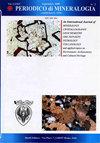粉末冶金法分析磷酸三钙镁复合材料的力学和物理性能
IF 1.2
4区 地球科学
Q3 GEOCHEMISTRY & GEOPHYSICS
引用次数: 0
摘要
本文研究了利用粉末冶金技术合成可生物降解的金属镁基复合材料,并将其应用于骨板植入物,具有良好的生物相容性;而镁合金表现出良好的相容性,但其机械性能不足以作为可降解材料用于骨植入物。采用粉末冶金和热挤压法制备了含有(2、4、6、8、10wt.%)三磷酸钙(TCP) [ca3 (po4) 2] 5个重量分数的ZK30镁合金的金属镁基复合材料。研究了材料的硬度、密度、孔隙率、拉伸和压缩等力学性能。Mg复合材料的显微硬度随TCP颗粒质量分数的增加而降低,并随TCP颗粒质量分数的增加而变化。ZK30镁合金及其复合材料具有比人骨更高的显微硬度。在大多数情况下,具有重量分数的复合密度似乎提高了实验密度,而孔隙率却减少了。ZK30/4wt%TCP具有较高的极限拉伸强度,达到241.462MPa,而ZK30/10wt%TCP的极限拉伸强度最低为151.169MPa。然而,对于ZK30/4wt%的TCP,由于ZK30镁合金基体与增强体之间良好的原子间键合,拉伸强度有所提高。ZK30/2wt.%TCP的极限抗压强度为241.462MPa。镁合金及其复合材料的抗拉、抗压强度均高于人骨。拉伸和压缩试验的扫描电镜观察表明,ZK30镁合金呈韧性断裂,Mg复合材料呈脆性断裂。随着TCP颗粒质量分数的增加,Mg复合材料的显微硬度、抗拉强度和抗压强度均下降。镁复合材料表现出良好的力学性能;因此,它是骨板植入的一个很好的选择。本文章由计算机程序翻译,如有差异,请以英文原文为准。
Analysis of Mechanical and Physical Properties on Magnesium Tricalcium Phosphate Composite by Powder Metallurgy
Thiswork is on the synthesis of biodegradable Magnesium metal matrix composites using power metallurgy technique for the application of bone plate implants, which exhibit excellent biocompatibility; whereas Magnesium alloys show good compatibility but their mechanical properties are not that good enough for using as degradable materials for bone implants. Magnesium metal matrix composites containing ZK30 Magnesium alloy with five weight fractions of (2, 4, 6, 8, 10wt.%) Tri-Calcium Phosphate (TCP) [Ca 3 (PO 4 ) 2 ] have been produced using powder metallurgy followed by hot extrusion for consolidation. The mechanical properties such as Hardness, Density, Porosity, Tensile and Compression tests were investigated. The micro hardness of Mg composites is found decreasing on increasing wt.% of TCP particles, also it can vary depending upon the quantity of TCP particles. The ZK30 Mg alloy and Mg composites have higher micro hardness than human bone. The composite density with weight fractions appears to have improved experimental density in most cases, whereas the porosity is found less. The ZK30/4wt%TCP holds a higher ultimate tensile strength of 241.462MPa whereas ZK30/10wt%TCP gives a minimum of 151.169MPa. However, for ZK30/4wt%TCP an increase in tensile strength is observed due to excellent inter atomic bonding between the ZK30 Mg alloy matrix and the reinforcement. A reasonably good ultimate compressive strength of 241.462MPa was recorded for ZK30/2wt.%TCP. However, the tested Mg alloy and the composites show higher tensile and compressive strength than human bone. The SEM observation in tensile and compression tests depict ductile fracture for ZK30 Mg alloy and brittle fracture for Mg composites. The micro hardness, tensile strength and compressive strength of Mg composites decreased on increasing wt.% of TCP particles. The Magnesium composite showed appropriate mechanical properties; thus, it is found a good choice for bone plates implants.
求助全文
通过发布文献求助,成功后即可免费获取论文全文。
去求助
来源期刊

Periodico Di Mineralogia
地学-地球化学与地球物理
CiteScore
1.50
自引率
14.30%
发文量
0
审稿时长
>12 weeks
期刊介绍:
Periodico di Mineralogia is an international peer-reviewed Open Access journal publishing Research Articles, Letters and Reviews in Mineralogy, Crystallography, Geochemistry, Ore Deposits, Petrology, Volcanology and applied topics on Environment, Archaeometry and Cultural Heritage. The journal aims at encouraging scientists to publish their experimental and theoretical results in as much detail as possible. Accordingly, there is no restriction on article length. Additional data may be hosted on the web sites as Supplementary Information. The journal does not have article submission and processing charges. Colour is free of charges both on line and printed and no Open Access fees are requested. Short publication time is assured.
Periodico di Mineralogia is property of Sapienza Università di Roma and is published, both online and printed, three times a year.
 求助内容:
求助内容: 应助结果提醒方式:
应助结果提醒方式:


